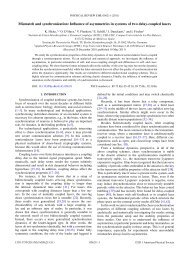DBI Analysis of Open String Bound States on Non-compact D-branes
DBI Analysis of Open String Bound States on Non-compact D-branes
DBI Analysis of Open String Bound States on Non-compact D-branes
You also want an ePaper? Increase the reach of your titles
YUMPU automatically turns print PDFs into web optimized ePapers that Google loves.
CHAPTER 5. BRANES 67Also remark that it are <strong>on</strong>ly the endpoints <str<strong>on</strong>g>of</str<strong>on</strong>g> the open string that are fixed; all otherpoints <strong>on</strong> the string are still free to move as they please.D-<strong>branes</strong>As we have just introduced them, Dp-<strong>branes</strong> are physical objects that extend in p spatialdimensi<strong>on</strong>s, and whose defining property is that the endpoints <str<strong>on</strong>g>of</str<strong>on</strong>g> open strings satisfyingDirichlet boundary c<strong>on</strong>diti<strong>on</strong>s can (or even have to) end <strong>on</strong> them. We see that in essence,D-<strong>branes</strong> were present right from the start, <strong>on</strong>ly betraying their presence through theDirichlet boundary c<strong>on</strong>diti<strong>on</strong>s which first got dismissed as being unphysical due to thefact that they break Poincaré invariance. As a c<strong>on</strong>sequence, they <strong>on</strong>ly grew in popularitywhen T-duality was discovered in 1989.As an intuitive argument 4 as to why these objects should behave like physical objects,c<strong>on</strong>sider this next scenario. An open string fixed to a D-brane moves around untilsomehow both its endpoints meet. As <str<strong>on</strong>g>of</str<strong>on</strong>g> that moment, the string becomes a closedstring, and hence is no l<strong>on</strong>ger bound to the surface <str<strong>on</strong>g>of</str<strong>on</strong>g> this D-brane. Instead, it can get<str<strong>on</strong>g>of</str<strong>on</strong>g>, and roam around in space-time, enjoying the sight. But at some point, it might hitanother D-brane, at which time it can “open up” again, and become fixed to the surface<str<strong>on</strong>g>of</str<strong>on</strong>g> this other D-brane. In this case, two D-<strong>branes</strong> will have exchanged a (closed) string,and hence, talked to each other. Only physical objects can interact, hence implying thatD-<strong>branes</strong> should indeed be physical.Something crucial happens to the spectrum <str<strong>on</strong>g>of</str<strong>on</strong>g> open strings with Dirichlet boundaryc<strong>on</strong>diti<strong>on</strong>s. We now know that if a string has Neumann c<strong>on</strong>diti<strong>on</strong>s in some directi<strong>on</strong>s, letus say 0 to p (with 1 ≤ p < 25), and Dirichlet in the others, this amounts to saying thatthis string has endpoints lying <strong>on</strong> a p-brane. We can now denote the Neumann directi<strong>on</strong>swith an index n and the Dirichlet directi<strong>on</strong>s with an index d, i.e. X µ = { X n , X d} withn ∈ {0, . . .,p} and d ∈ {p + 1, . . .,25}. The next step is to combine X 0 and X 1 intolight-c<strong>on</strong>e coordinates, so that we can use the light-c<strong>on</strong>e gauge to c<strong>on</strong>struct the spectrum<str<strong>on</strong>g>of</str<strong>on</strong>g> this string. After we do this, we are left with (p − 1) transverse Neumann directi<strong>on</strong>s,and thus (p − 1) α−1 i operators (i ∈ {2, . . .,p}) we can let act <strong>on</strong> our groundstate. Ifwe use these operators, we create a massless state, just as we saw in Chapter 2, butthis time in (p − 1) <str<strong>on</strong>g>of</str<strong>on</strong>g> the dimensi<strong>on</strong>s in which our Dp-brane is stretched. We create aphot<strong>on</strong> that lives <strong>on</strong> the D-brane! Hence, every Dp-brane has a Maxwell field living <strong>on</strong>its world volume. The α−1 d operators generate states that from the point <str<strong>on</strong>g>of</str<strong>on</strong>g> view <str<strong>on</strong>g>of</str<strong>on</strong>g> theD-brane transform as scalars. All these fields are perpendicular to the D-brane worldvolume. They can be regarded as excitati<strong>on</strong>s <str<strong>on</strong>g>of</str<strong>on</strong>g> the D-brane itself.This last point gives rise to a nice way <str<strong>on</strong>g>of</str<strong>on</strong>g> eliminating tachy<strong>on</strong>s from the open stringbos<strong>on</strong>ic spectrum. It has been suggested that a space-time filling D25-brane is unstablebecause <str<strong>on</strong>g>of</str<strong>on</strong>g> the tachy<strong>on</strong> that lives <strong>on</strong> its world volume. Because <str<strong>on</strong>g>of</str<strong>on</strong>g> this, the D25-branewould actually decay, and the products <str<strong>on</strong>g>of</str<strong>on</strong>g> this decay would be closed strings. This isalso true for Dp-<strong>branes</strong> with p < 25. As a c<strong>on</strong>sequence, bos<strong>on</strong>ic string theory couldvery well not c<strong>on</strong>tain any stable D-<strong>branes</strong> at all. As <str<strong>on</strong>g>of</str<strong>on</strong>g> yet, no way has been found toeliminate the closed string tachy<strong>on</strong>, though.4 This argument has been taken from [5].
















